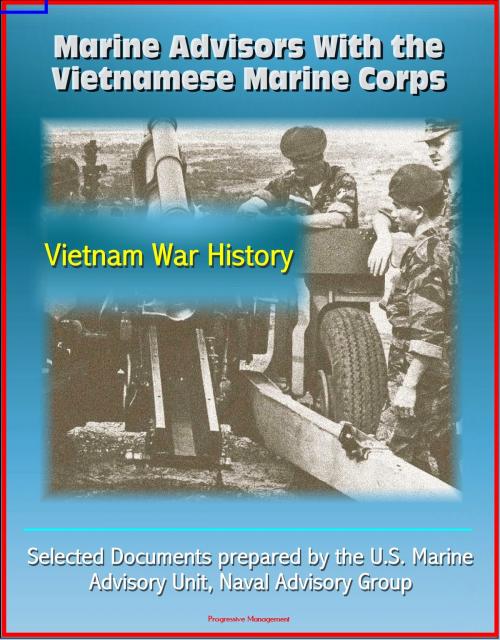Marine Advisors With the Vietnamese Marine Corps: Selected Documents prepared by the U.S. Marine Advisory Unit, Naval Advisory Group, Vietnam War History
Nonfiction, History, Military, Vietnam War, Asian| Author: | Progressive Management | ISBN: | 9781301959167 |
| Publisher: | Progressive Management | Publication: | December 19, 2012 |
| Imprint: | Smashwords Edition | Language: | English |
| Author: | Progressive Management |
| ISBN: | 9781301959167 |
| Publisher: | Progressive Management |
| Publication: | December 19, 2012 |
| Imprint: | Smashwords Edition |
| Language: | English |
The period after World War II saw a number of associated Marine Corps formed in the republics of China, Korea, Vietnam, the Philippines, Indonesia, and Thailand. They had been founded, with the help of foreign military aid, to fight the various conflicts to contain communist expansion in the region. Also present at various times were other Marines from the Netherlands, France, and Great Britain. The beginnings of the Cold War witnessed this proliferation of amphibious forces in Asia, in part because of the reputation the U.S. Marines had earned in the cross Pacific drive against Japan and in other postwar confrontations. This is about one of them, the Vietnamese Marine Corps or Thuy Quan Luc Chien (TQLC). This paper provides documents on the topics of the Vietnamese Marines and the U.S. Marine Advisory Unit from this period.
Three Corps fought together in Vietnam from 1965 through 1973. Each of these was a similar formation, but with its own history and traditions: the United States Marines, the Vietnamese Marines, and the Korean Marines. Common to each was a reputation for toughness on themselves and any enemy, strong unit pride, and loyalty with a privileged place within the defense structure of their respective countries. This is the story of one of them.
When the French departed Indochina, they left behind the fledgling armed forces of the Vietnamese republic. Included were the riverine forces of the navy and an assortment of army commandos that had provided the troops for them. These had formed the river assault divisions (Dinassauts) that Dr. Bernard B. Fall observed as "one of a few worthwhile contributions" to military tactics of the First Indochina War (1945-1954). After the Geneva Agreement that arranged the withdrawal of France from Indochina and the partition of Vietnam into north and south pending elections, the Americans moved to help the government of South Vietnam against the communist bloc-supported People's Republic of Vietnam. The commandos were formed into two battalions and grouped at Nha Trang when the separation of Vietnam into north and south was completed.
Contents: The Vietnamese Marine Corps, 1954-1975 * Senior U.S. Marine Advisors, 1954-1975 * Document: SAB [Senior Advisor Brief] Helpful Hints * Document: What You Should Know When Assigned to a Vietnamese Marine Battalion as an Advisor * Document: Techniques of Advising * Document: Standing Operation Procedures for Marine Advisory Unit * U.S. Marine Advisors to the Vietnamese Marine Corps, 1954-1975 * Further Reading * Oral Histories
The period after World War II saw a number of associated Marine Corps formed in the republics of China, Korea, Vietnam, the Philippines, Indonesia, and Thailand. They had been founded, with the help of foreign military aid, to fight the various conflicts to contain communist expansion in the region. Also present at various times were other Marines from the Netherlands, France, and Great Britain. The beginnings of the Cold War witnessed this proliferation of amphibious forces in Asia, in part because of the reputation the U.S. Marines had earned in the cross Pacific drive against Japan and in other postwar confrontations. This is about one of them, the Vietnamese Marine Corps or Thuy Quan Luc Chien (TQLC). This paper provides documents on the topics of the Vietnamese Marines and the U.S. Marine Advisory Unit from this period.
Three Corps fought together in Vietnam from 1965 through 1973. Each of these was a similar formation, but with its own history and traditions: the United States Marines, the Vietnamese Marines, and the Korean Marines. Common to each was a reputation for toughness on themselves and any enemy, strong unit pride, and loyalty with a privileged place within the defense structure of their respective countries. This is the story of one of them.
When the French departed Indochina, they left behind the fledgling armed forces of the Vietnamese republic. Included were the riverine forces of the navy and an assortment of army commandos that had provided the troops for them. These had formed the river assault divisions (Dinassauts) that Dr. Bernard B. Fall observed as "one of a few worthwhile contributions" to military tactics of the First Indochina War (1945-1954). After the Geneva Agreement that arranged the withdrawal of France from Indochina and the partition of Vietnam into north and south pending elections, the Americans moved to help the government of South Vietnam against the communist bloc-supported People's Republic of Vietnam. The commandos were formed into two battalions and grouped at Nha Trang when the separation of Vietnam into north and south was completed.
Contents: The Vietnamese Marine Corps, 1954-1975 * Senior U.S. Marine Advisors, 1954-1975 * Document: SAB [Senior Advisor Brief] Helpful Hints * Document: What You Should Know When Assigned to a Vietnamese Marine Battalion as an Advisor * Document: Techniques of Advising * Document: Standing Operation Procedures for Marine Advisory Unit * U.S. Marine Advisors to the Vietnamese Marine Corps, 1954-1975 * Further Reading * Oral Histories















